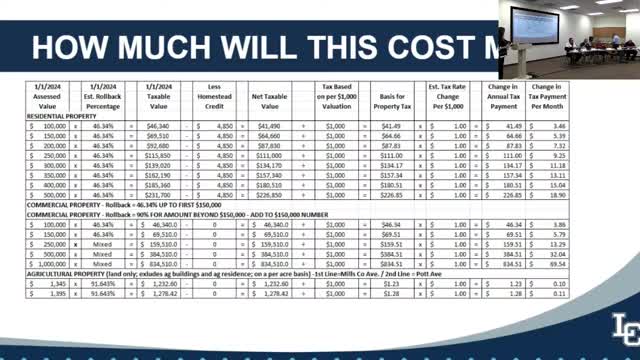Property tax changes spark confusion among homeowners
October 09, 2024 | Lewis Central Comm School District, School Districts, Iowa
This article was created by AI summarizing key points discussed. AI makes mistakes, so for full details and context, please refer to the video of the full meeting. Please report any errors so we can fix them. Report an error »

In a recent government meeting, Mac Gillespie from Piper Sandler presented a detailed analysis of property tax assessments and their implications for homeowners in the district. The discussion highlighted a significant decrease in property tax burdens compared to the previous year, with homeowners of $350,000 properties facing an annual tax of only $157, down from $500.
Gillespie explained that property values are assessed based on data from the previous January, meaning the current fiscal year reflects values from January 2023. This year, residential property assessments have risen significantly, but the taxable value—upon which taxes are levied—has been adjusted due to a state-mandated rollback. This rollback percentage decreased from 54.6% to 46.3%, which means that while assessed values increased, the actual taxable values did not rise proportionately, resulting in lower tax bills for many homeowners.
The meeting also revealed that residential properties contribute 43.6% of the total property taxes in the district, while commercial properties account for 43.9%. This unusual distribution means that commercial property owners bear a larger share of the tax burden, benefiting residential homeowners by keeping their tax rates lower.
Gillespie emphasized the importance of understanding the difference between assessed and taxable values, noting that many homeowners mistakenly believe their taxes will increase in line with assessed values. He provided examples illustrating that despite significant increases in assessed values, many homeowners are actually paying less in taxes this year compared to last.
The discussion concluded with a preview of potential future bond issuances for school funding, suggesting that the district may opt for a quicker repayment plan to minimize interest costs. Overall, the meeting provided clarity on property tax dynamics and reassured homeowners about their financial obligations in light of rising property values.
Gillespie explained that property values are assessed based on data from the previous January, meaning the current fiscal year reflects values from January 2023. This year, residential property assessments have risen significantly, but the taxable value—upon which taxes are levied—has been adjusted due to a state-mandated rollback. This rollback percentage decreased from 54.6% to 46.3%, which means that while assessed values increased, the actual taxable values did not rise proportionately, resulting in lower tax bills for many homeowners.
The meeting also revealed that residential properties contribute 43.6% of the total property taxes in the district, while commercial properties account for 43.9%. This unusual distribution means that commercial property owners bear a larger share of the tax burden, benefiting residential homeowners by keeping their tax rates lower.
Gillespie emphasized the importance of understanding the difference between assessed and taxable values, noting that many homeowners mistakenly believe their taxes will increase in line with assessed values. He provided examples illustrating that despite significant increases in assessed values, many homeowners are actually paying less in taxes this year compared to last.
The discussion concluded with a preview of potential future bond issuances for school funding, suggesting that the district may opt for a quicker repayment plan to minimize interest costs. Overall, the meeting provided clarity on property tax dynamics and reassured homeowners about their financial obligations in light of rising property values.
View full meeting
This article is based on a recent meeting—watch the full video and explore the complete transcript for deeper insights into the discussion.
View full meeting
